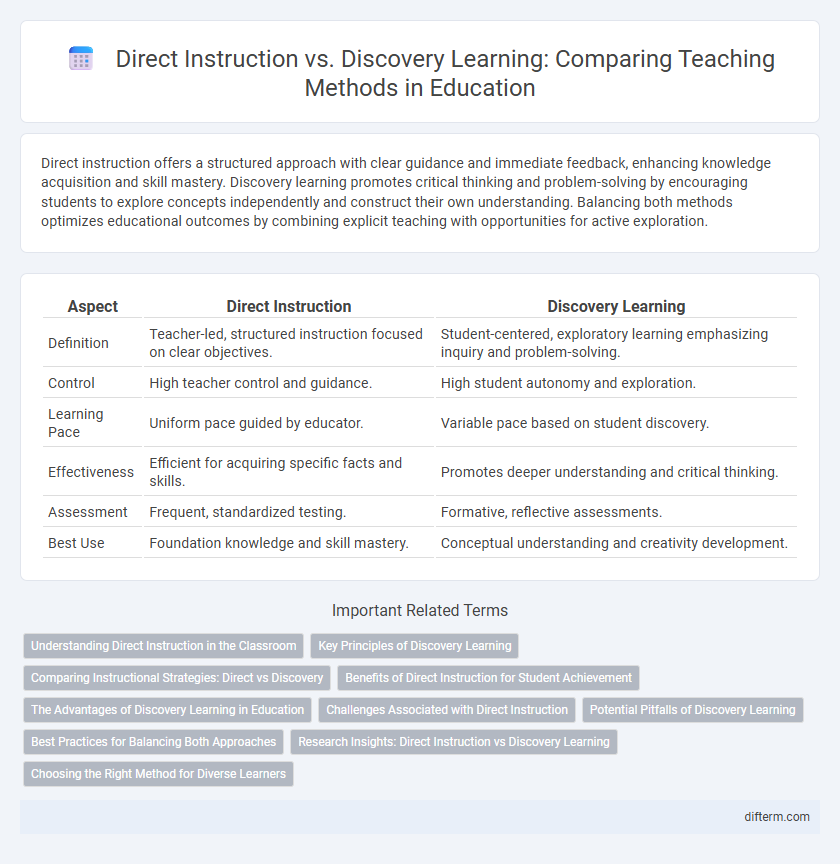Direct instruction offers a structured approach with clear guidance and immediate feedback, enhancing knowledge acquisition and skill mastery. Discovery learning promotes critical thinking and problem-solving by encouraging students to explore concepts independently and construct their own understanding. Balancing both methods optimizes educational outcomes by combining explicit teaching with opportunities for active exploration.
Table of Comparison
| Aspect | Direct Instruction | Discovery Learning |
|---|---|---|
| Definition | Teacher-led, structured instruction focused on clear objectives. | Student-centered, exploratory learning emphasizing inquiry and problem-solving. |
| Control | High teacher control and guidance. | High student autonomy and exploration. |
| Learning Pace | Uniform pace guided by educator. | Variable pace based on student discovery. |
| Effectiveness | Efficient for acquiring specific facts and skills. | Promotes deeper understanding and critical thinking. |
| Assessment | Frequent, standardized testing. | Formative, reflective assessments. |
| Best Use | Foundation knowledge and skill mastery. | Conceptual understanding and creativity development. |
Understanding Direct Instruction in the Classroom
Direct instruction in the classroom emphasizes structured, teacher-led lessons designed to ensure clear and measurable learning outcomes. This method employs explicit teaching techniques, such as modeling, guided practice, and immediate feedback, which boost student comprehension and retention of material. Research indicates that direct instruction is particularly effective for foundational skills and when teaching complex or new concepts.
Key Principles of Discovery Learning
Discovery learning emphasizes active student engagement through exploration and problem-solving, fostering deep comprehension and long-term retention. It relies on scaffolded guidance to support learners in constructing their own understanding rather than passively receiving information. This approach encourages critical thinking, adaptability, and intrinsic motivation by allowing students to uncover principles and relationships independently.
Comparing Instructional Strategies: Direct vs Discovery
Direct instruction emphasizes structured, teacher-led lessons with clear objectives and immediate feedback, promoting efficient knowledge transfer and skill mastery. Discovery learning encourages students to explore concepts independently or collaboratively, fostering critical thinking and deeper understanding through experiential engagement. Comparing these, direct instruction suits foundational skill acquisition, while discovery learning benefits conceptual grasp and creativity in education.
Benefits of Direct Instruction for Student Achievement
Direct instruction accelerates student achievement by providing clear, explicit teaching that minimizes confusion and maximizes learning efficiency. Research shows students receiving direct instruction demonstrate higher test scores and improved mastery of foundational skills compared to discovery learning approaches. Structured lessons in direct instruction enhance knowledge retention and support differentiated instruction tailored to diverse learning needs.
The Advantages of Discovery Learning in Education
Discovery learning promotes critical thinking and problem-solving skills by encouraging students to actively engage with the material and explore concepts independently. It fosters deeper understanding and retention through hands-on experiences and real-world application, enhancing students' motivation and curiosity. This student-centered approach supports personalized learning, allowing learners to construct knowledge at their own pace and develop creativity.
Challenges Associated with Direct Instruction
Direct instruction faces challenges such as limited opportunities for student creativity and critical thinking, potentially leading to passive learning experiences. Its highly structured format may not address diverse learning styles, causing difficulties for students who benefit from more exploratory approaches. Teachers also risk over-relying on scripted lessons, reducing adaptability and responsiveness to individual student needs.
Potential Pitfalls of Discovery Learning
Discovery learning can lead to misconceptions and incomplete understanding due to insufficient guidance, especially for novice learners. Students may struggle with cognitive overload when faced with complex problems without structured support, impeding effective knowledge acquisition. Lack of clear objectives and feedback in discovery learning environments often results in inefficient use of instructional time and reduced academic achievement.
Best Practices for Balancing Both Approaches
Effective education integrates direct instruction's structured content delivery with discovery learning's emphasis on student exploration to optimize comprehension and engagement. Incorporating clear learning objectives and timely feedback in direct instruction complements discovery learning's promotion of critical thinking and problem-solving skills. Balancing these methods involves strategically sequencing lessons to introduce foundational knowledge first, followed by exploratory activities that reinforce and apply concepts in meaningful contexts.
Research Insights: Direct Instruction vs Discovery Learning
Research consistently shows that direct instruction leads to higher student achievement and better retention of information compared to discovery learning. Studies highlight that structured lessons with explicit teaching help learners grasp complex concepts more efficiently, especially in subjects like mathematics and science. However, discovery learning promotes critical thinking and problem-solving skills, making it valuable for fostering creativity and deeper understanding when combined appropriately with direct instruction.
Choosing the Right Method for Diverse Learners
Direct instruction provides structured, clear guidance that benefits learners needing explicit support and quick mastery of foundational skills. Discovery learning fosters critical thinking and problem-solving, ideal for students who thrive in exploratory and self-paced environments. Educators should assess learners' cognitive styles, prior knowledge, and motivational factors to select the most effective method, potentially integrating both approaches for optimal engagement and comprehension.
direct instruction vs discovery learning Infographic

 difterm.com
difterm.com